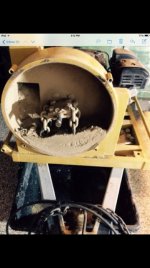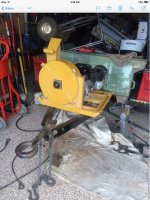A friend and I are gonna be building an impact crusher over the next couple weekends. He's got access to endless scrap and fancy cutting and bending tools at his work and I've got the tools to put it together. We're leaning towards the octagon shape over round, belt driven with a clutch (belt tension pulley w/ lever), and something other than chain for hammers, maybe using an old cutting edge off a bucket? not sure yet. Thank you.
My questions for you:
-what shape?
-dimensions (diameter & width of housing)?
-engine hp?
-flywheel?
-belt or direct drive?
-with or without clutch mechanism?
-gear ratio for belt drive?
-single or multiple belt?
-any noticeable belt slip?
-shaft size?
-shaft offset from center?
-how many hammers?
-spacing between hammers?
-what are the impact hammers made of and how do they hold up
-any internal armor or hard-facing on hammers?
-intake and discharge sizes?
-intake and discharge placement on housing?
-what are the things you like about yours?
-what would you change about it?
-high wear parts?
-any incurred damage?
My questions for you:
-what shape?
-dimensions (diameter & width of housing)?
-engine hp?
-flywheel?
-belt or direct drive?
-with or without clutch mechanism?
-gear ratio for belt drive?
-single or multiple belt?
-any noticeable belt slip?
-shaft size?
-shaft offset from center?
-how many hammers?
-spacing between hammers?
-what are the impact hammers made of and how do they hold up
-any internal armor or hard-facing on hammers?
-intake and discharge sizes?
-intake and discharge placement on housing?
-what are the things you like about yours?
-what would you change about it?
-high wear parts?
-any incurred damage?










